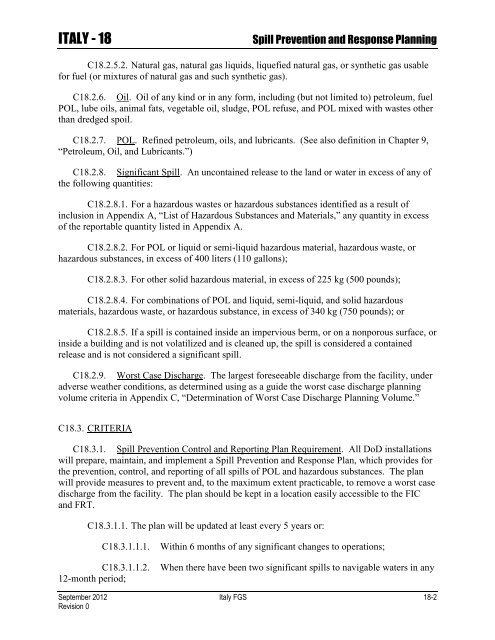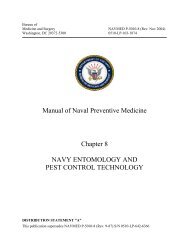ENVIRONMENTAL FINAL GOVERNING STANDARDS ITALY
ENVIRONMENTAL FINAL GOVERNING STANDARDS ITALY
ENVIRONMENTAL FINAL GOVERNING STANDARDS ITALY
You also want an ePaper? Increase the reach of your titles
YUMPU automatically turns print PDFs into web optimized ePapers that Google loves.
<strong>ITALY</strong> - 18 Spill Prevention and Response Planning<br />
C18.2.5.2. Natural gas, natural gas liquids, liquefied natural gas, or synthetic gas usable<br />
for fuel (or mixtures of natural gas and such synthetic gas).<br />
C18.2.6. Oil. Oil of any kind or in any form, including (but not limited to) petroleum, fuel<br />
POL, lube oils, animal fats, vegetable oil, sludge, POL refuse, and POL mixed with wastes other<br />
than dredged spoil.<br />
C18.2.7. POL. Refined petroleum, oils, and lubricants. (See also definition in Chapter 9,<br />
“Petroleum, Oil, and Lubricants.”)<br />
C18.2.8. Significant Spill. An uncontained release to the land or water in excess of any of<br />
the following quantities:<br />
C18.2.8.1. For a hazardous wastes or hazardous substances identified as a result of<br />
inclusion in Appendix A, “List of Hazardous Substances and Materials,” any quantity in excess<br />
of the reportable quantity listed in Appendix A.<br />
C18.2.8.2. For POL or liquid or semi-liquid hazardous material, hazardous waste, or<br />
hazardous substances, in excess of 400 liters (110 gallons);<br />
C18.2.8.3. For other solid hazardous material, in excess of 225 kg (500 pounds);<br />
C18.2.8.4. For combinations of POL and liquid, semi-liquid, and solid hazardous<br />
materials, hazardous waste, or hazardous substance, in excess of 340 kg (750 pounds); or<br />
C18.2.8.5. If a spill is contained inside an impervious berm, or on a nonporous surface, or<br />
inside a building and is not volatilized and is cleaned up, the spill is considered a contained<br />
release and is not considered a significant spill.<br />
C18.2.9. Worst Case Discharge. The largest foreseeable discharge from the facility, under<br />
adverse weather conditions, as determined using as a guide the worst case discharge planning<br />
volume criteria in Appendix C, “Determination of Worst Case Discharge Planning Volume.”<br />
C18.3. CRITERIA<br />
C18.3.1. Spill Prevention Control and Reporting Plan Requirement. All DoD installations<br />
will prepare, maintain, and implement a Spill Prevention and Response Plan, which provides for<br />
the prevention, control, and reporting of all spills of POL and hazardous substances. The plan<br />
will provide measures to prevent and, to the maximum extent practicable, to remove a worst case<br />
discharge from the facility. The plan should be kept in a location easily accessible to the FIC<br />
and FRT.<br />
C18.3.1.1. The plan will be updated at least every 5 years or:<br />
C18.3.1.1.1. Within 6 months of any significant changes to operations;<br />
C18.3.1.1.2. When there have been two significant spills to navigable waters in any<br />
12-month period;<br />
September 2012 Italy FGS 18-2<br />
Revision 0
















